独立主格结构总结及练习
- 格式:doc
- 大小:157.50 KB
- 文档页数:35
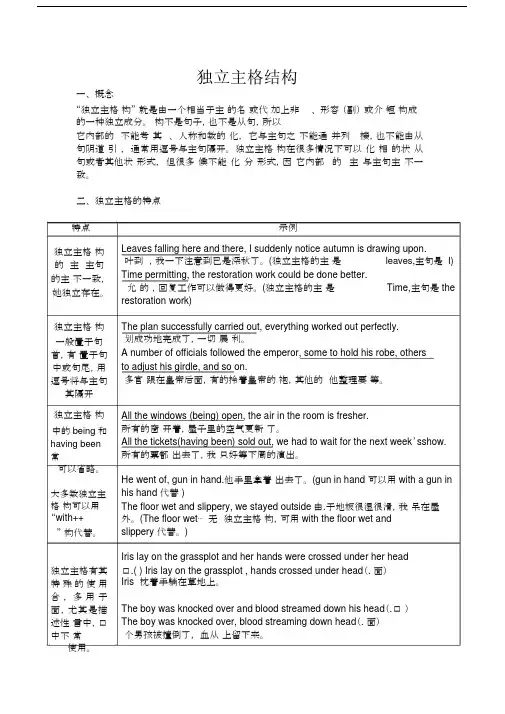
独立主格结构一、概念“独立主格构” 就是由一个相当于主的名或代加上非、形容(副)或介短构成的一种独立成分。
构不是句子,也不是从句,所以它内部的不能考其、人称和数的化,它与主句之不能通并列接,也不能由从句阴道引,通常用逗号与主句隔开。
独立主格构在很多情况下可以化相的状从句或者其他状形式,但很多候不能化分形式,因它内部的主与主句主不一致。
二、独立主格的特点特点独立主格构的主主句的主不一致,她独立存在。
独立主格构一般置于句首,有置于句中或句尾,用逗号将与主句其隔开独立主格构中的 being 和having been 常可以省略。
大多数独立主格构可以用“with++” 构代替。
独立主格有其特殊的使用合,多用于面,尤其是描述性言中,口中不常使用。
示例Leaves falling here and there, I suddenly notice autumn is drawing upon.叶到,我一下注意到已是深秋了。
(独立主格的主是leaves,主句是 I) Time permitting, the restoration work could be done better.允的,回复工作可以做得更好。
(独立主格的主是Time,主句是 the restoration work)The plan successfully carried out, everything worked out perfectly.划成功地完成了,一切展利。
A number of officials followed the emperor, some to hold his robe, othersto adjust his girdle, and so on.多官跟在皇帝后面,有的拎着皇帝的袍,其他的他整理要等。
All the windows (being) open, the air in the room is fresher.所有的窗开着,屋子里的空气更新了。
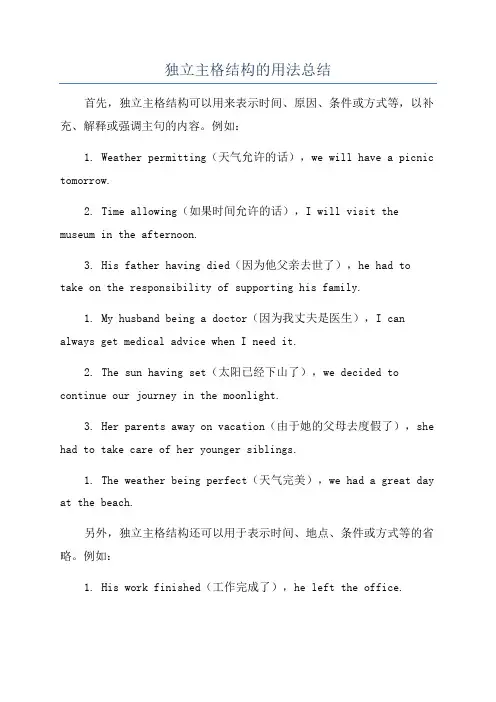
独立主格结构的用法总结首先,独立主格结构可以用来表示时间、原因、条件或方式等,以补充、解释或强调主句的内容。
例如:1. Weather permitting(天气允许的话),we will have a picnic tomorrow.2. Time allowing(如果时间允许的话),I will visit the museum in the afternoon.3. His father having died(因为他父亲去世了),he had to take on the responsibility of supporting his family.1. My husband being a doctor(因为我丈夫是医生),I can always get medical advice when I need it.2. The sun having set(太阳已经下山了),we decided to continue our journey in the moonlight.3. Her parents away on vacation(由于她的父母去度假了),she had to take care of her younger siblings.1. The weather being perfect(天气完美),we had a great day at the beach.另外,独立主格结构还可以用于表示时间、地点、条件或方式等的省略。
例如:1. His work finished(工作完成了),he left the office.2. The train arrived(火车到站了),we boarded and found our seats.3. The road wet(路面湿滑),drivers should slow down and be cautious.需要注意的是,独立主格结构中的名词或代词通常是主句中的逻辑主语,而独立主格结构表示的是其动作或状态。
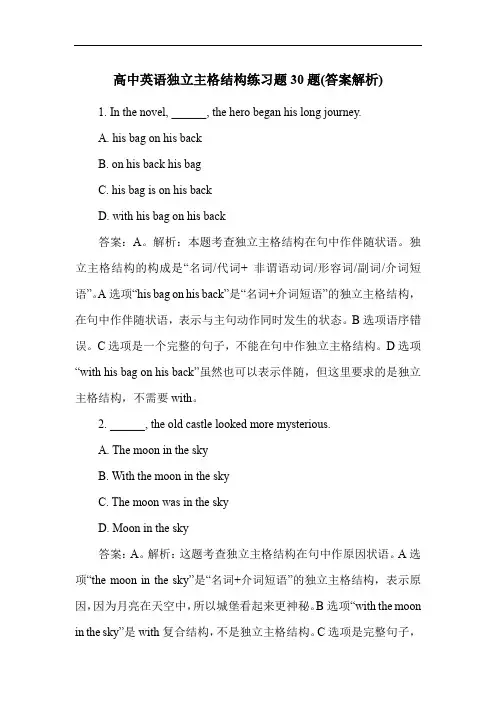
高中英语独立主格结构练习题30题(答案解析)1. In the novel, ______, the hero began his long journey.A. his bag on his backB. on his back his bagC. his bag is on his backD. with his bag on his back答案:A。
解析:本题考查独立主格结构在句中作伴随状语。
独立主格结构的构成是“名词/代词+ 非谓语动词/形容词/副词/介词短语”。
A选项“his bag on his back”是“名词+介词短语”的独立主格结构,在句中作伴随状语,表示与主句动作同时发生的状态。
B选项语序错误。
C选项是一个完整的句子,不能在句中作独立主格结构。
D选项“with his bag on his back”虽然也可以表示伴随,但这里要求的是独立主格结构,不需要with。
2. ______, the old castle looked more mysterious.A. The moon in the skyB. With the moon in the skyC. The moon was in the skyD. Moon in the sky答案:A。
解析:这题考查独立主格结构在句中作原因状语。
A选项“the moon in the sky”是“名词+介词短语”的独立主格结构,表示原因,因为月亮在天空中,所以城堡看起来更神秘。
B选项“with the moon in the sky”是with复合结构,不是独立主格结构。
C选项是完整句子,不能作独立主格结构。
D选项“Moon”首字母没有大写,并且这种表达不完整。
3. ______, the story has a happy ending.A. All things consideredB. All things were consideredC. Considered all thingsD. With all things considered答案:A。

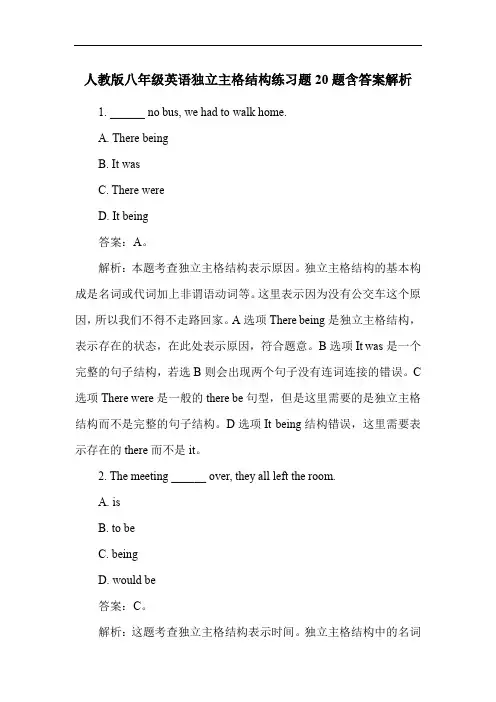
人教版八年级英语独立主格结构练习题20题含答案解析1. ______ no bus, we had to walk home.A. There beingB. It wasC. There wereD. It being答案:A。
解析:本题考查独立主格结构表示原因。
独立主格结构的基本构成是名词或代词加上非谓语动词等。
这里表示因为没有公交车这个原因,所以我们不得不走路回家。
A选项There being是独立主格结构,表示存在的状态,在此处表示原因,符合题意。
B选项It was是一个完整的句子结构,若选B则会出现两个句子没有连词连接的错误。
C 选项There were是一般的there be句型,但是这里需要的是独立主格结构而不是完整的句子结构。
D选项It being结构错误,这里需要表示存在的there而不是it。
2. The meeting ______ over, they all left the room.A. isB. to beC. beingD. would be答案:C。
解析:这题考查独立主格结构表示时间。
独立主格结构中的名词the meeting与be动词的现在分词形式being构成独立主格结构,表示会议结束这个时间状态。
A选项is是一般现在时的谓语形式,若选A则会出现两个句子没有连词连接的错误。
B选项to be是不定式形式,不能表示这种时间状态。
D选项would be是过去将来时的谓语形式,不符合此处独立主格结构表示时间的要求。
3. Weather ______, we will go for a picnic tomorrow.A. permitB. permitsC. permittingD. permitted答案:C。
解析:这里考查独立主格结构表示条件。
Weather permitting是独立主格结构,意思是如果天气允许的话。
其中weather是名词,permitting是现在分词形式。
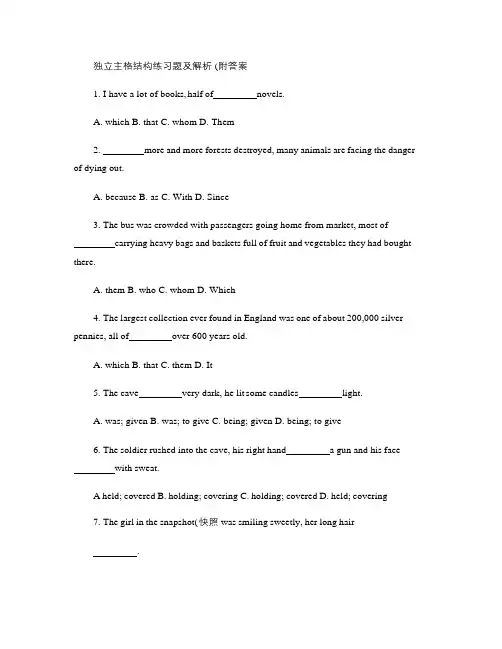
独立主格结构练习题及解析(附答案1.I have a lot of books, half of novels.A. whichB. thatC. whomD. Them2.more and more forests destroyed, many animals are facing the danger of dying out.A. becauseB. asC. WithD. Since3.The bus was crowded with passengers going home from market, most ofcarrying heavy bags and baskets full of fruit and vegetables they had bought there.A. themB. whoC. whomD. Which4.The largest collection ever found in England was one of about 200,000 silver pennies, all of over 600 years old.A. whichB. thatC. themD. It5.The cave very dark, he lit some candles light.A. was; givenB. was; to giveC. being; givenD. being; to give6.The soldier rushed into the cave, his right hand a gun and his facewith sweat.A held; covered B. holding; covering C. holding; covered D. held; covering7.The girl in the snapshot( 快照was smiling sweetly, her long hair.A. flowed in the breeze( 微风B. was flowing in the breezeC. were flowing in the breezeD. flowing in the breeze8.The children went home from the grammar school, their lessons for the day.A. finishingB. finishedC. had finishedD. were finished9.On Sundays there were a lot of children playing in the park, parents seated together joking.A. theirB. whoseC. whichD. That10.The Smiths are rich and they have three cars, one a Toyota, Land Rover of the latest.A. anotherB. otherC. the otherD. the others【答案与解析】1.D。
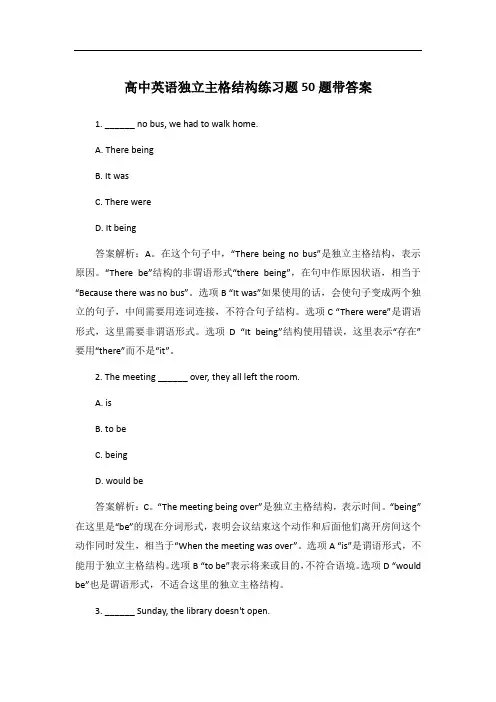
高中英语独立主格结构练习题50题带答案1. ______ no bus, we had to walk home.A. There beingB. It wasC. There wereD. It being答案解析:A。
在这个句子中,“There being no bus”是独立主格结构,表示原因。
“There be”结构的非谓语形式“there being”,在句中作原因状语,相当于“Because there was no bus”。
选项B “It was”如果使用的话,会使句子变成两个独立的句子,中间需要用连词连接,不符合句子结构。
选项C “There were”是谓语形式,这里需要非谓语形式。
选项D “It being”结构使用错误,这里表示“存在”要用“there”而不是“it”。
2. The meeting ______ over, they all left the room.A. isB. to beC. beingD. would be答案解析:C。
“The meeting being over”是独立主格结构,表示时间。
“being”在这里是“be”的现在分词形式,表明会议结束这个动作和后面他们离开房间这个动作同时发生,相当于“When the meeting was over”。
选项A “is”是谓语形式,不能用于独立主格结构。
选项B “to be”表示将来或目的,不符合语境。
选项D “would be”也是谓语形式,不适合这里的独立主格结构。
3. ______ Sunday, the library doesn't open.A. It beingB. As it isC. BeingD. It is答案解析:A。
“It being Sunday”是独立主格结构,表示原因。
这里“it”指代时间,“being”是现在分词,整个结构在句中作原因状语,相当于“Because it is Sunday”。
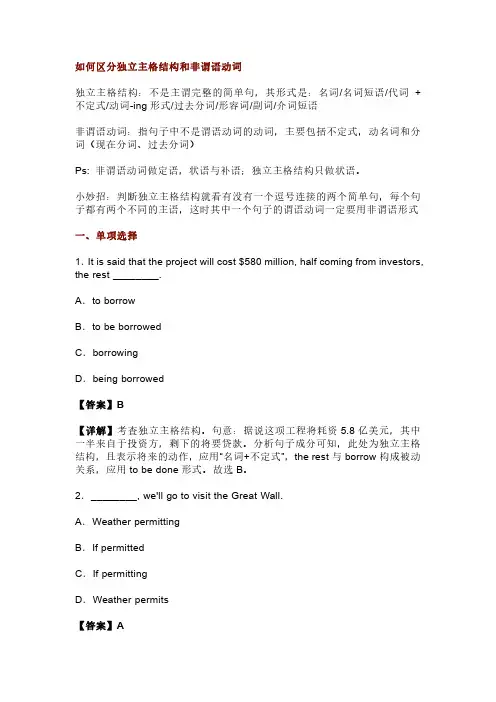
如何区分独立主格结构和非谓语动词独立主格结构:不是主谓完整的简单句,其形式是:名词/名词短语/代词+不定式/动词-ing形式/过去分词/形容词/副词/介词短语非谓语动词:指句子中不是谓语动词的动词,主要包括不定式,动名词和分词(现在分词、过去分词)Ps:非谓语动词做定语,状语与补语;独立主格结构只做状语。
小妙招:判断独立主格结构就看有没有一个逗号连接的两个简单句,每个句子都有两个不同的主语,这时其中一个句子的谓语动词一定要用非谓语形式一、单项选择1.It is said that the project will cost$580million,half coming from investors, the rest________.A.to borrowB.to be borrowedC.borrowingD.being borrowed【答案】B【详解】考查独立主格结构。
句意:据说这项工程将耗资5.8亿美元,其中一半来自于投资方,剩下的将要贷款。
分析句子成分可知,此处为独立主格结构,且表示将来的动作,应用“名词+不定式”,the rest与borrow构成被动关系,应用to be done形式。
故选B。
2.________,we'll go to visit the Great Wall.A.Weather permittingB.If permittedC.If permittingD.Weather permits【答案】A【详解】考查独立主格结构。
句意:如果天气允许,我们就去参观长城。
分析句子结构可知,逻辑主语与主句主语不一致,所以用独立主格结构。
weather 与permit之间为主动关系,所以用现在分词形式。
故选A。
3.After______by the heavy deluge,Henan province suffered from serious damages to its scenic spots,many tourists______in the disaster region. A.struck,were trappedB.being struck,trappedC.struck,having been trappedD.having been struck;were trapped【答案】B【详解】考查非谓语动词。
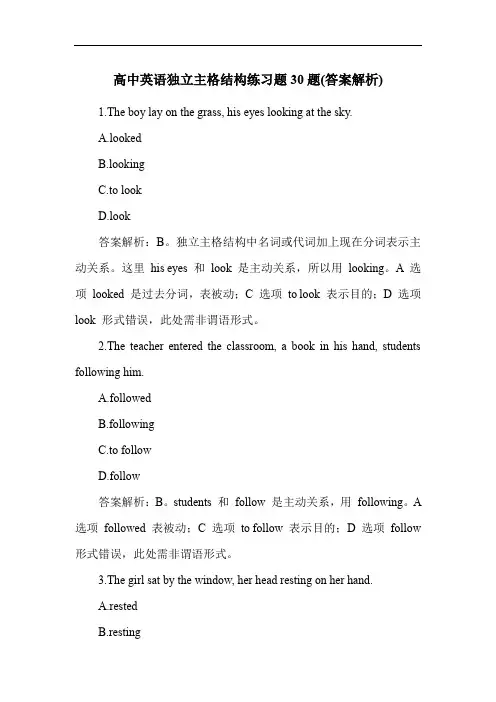
高中英语独立主格结构练习题30题(答案解析)1.The boy lay on the grass, his eyes looking at the sky.A.lookedB.lookingC.to lookD.look答案解析:B。
独立主格结构中名词或代词加上现在分词表示主动关系。
这里his eyes 和look 是主动关系,所以用looking。
A 选项looked 是过去分词,表被动;C 选项to look 表示目的;D 选项look 形式错误,此处需非谓语形式。
2.The teacher entered the classroom, a book in his hand, students following him.A.followedB.followingC.to followD.follow答案解析:B。
students 和follow 是主动关系,用following。
A 选项followed 表被动;C 选项to follow 表示目的;D 选项follow 形式错误,此处需非谓语形式。
3.The girl sat by the window, her head resting on her hand.A.restedB.restingD.rest答案解析:B。
her head 和rest 是主动关系,用resting。
A 选项rested 表被动;C 选项to rest 表示目的;D 选项rest 形式错误,此处需非谓语形式。
4.The dog lay under the tree, its tail wagging.A.waggedB.waggingC.to wagD.wag答案解析:B。
its tail 和wag 是主动关系,用wagging。
A 选项wagged 表被动;C 选项to wag 表示目的;D 选项wag 形式错误,此处需非谓语形式。
5.The man walked along the street, a hat on his head.A.was onB.being onC.onD.to be on答案解析:C。
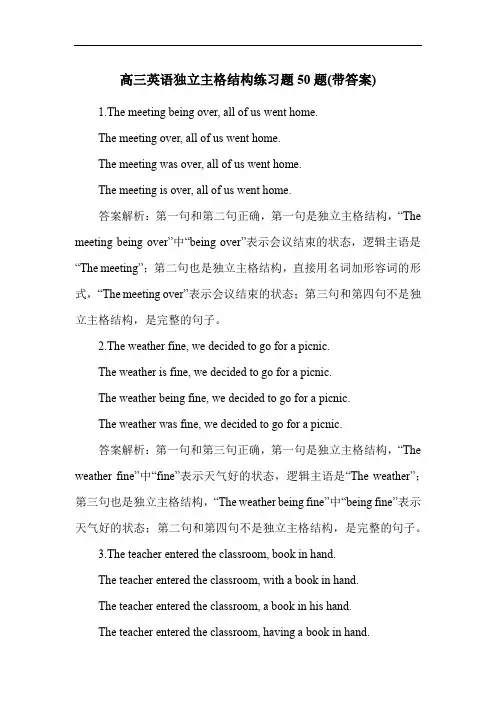
高三英语独立主格结构练习题50题(带答案)1.The meeting being over, all of us went home.The meeting over, all of us went home.The meeting was over, all of us went home.The meeting is over, all of us went home.答案解析:第一句和第二句正确,第一句是独立主格结构,“The meeting being over”中“being over”表示会议结束的状态,逻辑主语是“The meeting”;第二句也是独立主格结构,直接用名词加形容词的形式,“The meeting over”表示会议结束的状态;第三句和第四句不是独立主格结构,是完整的句子。
2.The weather fine, we decided to go for a picnic.The weather is fine, we decided to go for a picnic.The weather being fine, we decided to go for a picnic.The weather was fine, we decided to go for a picnic.答案解析:第一句和第三句正确,第一句是独立主格结构,“The weather fine”中“fine”表示天气好的状态,逻辑主语是“The weather”;第三句也是独立主格结构,“The weather being fine”中“being fine”表示天气好的状态;第二句和第四句不是独立主格结构,是完整的句子。
3.The teacher entered the classroom, book in hand.The teacher entered the classroom, with a book in hand.The teacher entered the classroom, a book in his hand.The teacher entered the classroom, having a book in hand.答案解析:第一句和第二句正确,第一句是独立主格结构,“book in hand”表示老师手里拿着书的状态,逻辑主语是“book”;第二句“with a book in hand”是“with + 宾语+ 介词短语”的结构,也可以表示老师手里拿着书的状态;第三句不是独立主格结构,是完整的句子;第四句不是标准的独立主格结构,“having a book in hand”不太符合习惯表达。
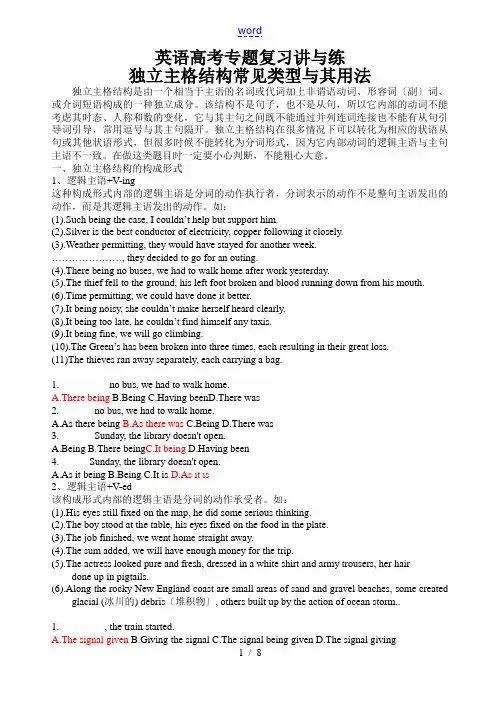
英语高考专题复习讲与练独立主格结构常见类型与其用法独立主格结构是由一个相当于主语的名词或代词加上非谓语动词、形容词〔副〕词、或介词短语构成的一种独立成分。
该结构不是句子,也不是从句,所以它内部的动词不能考虑其时态、人称和数的变化,它与其主句之间既不能通过并列连词连接也不能有从句引导词引导,常用逗号与其主句隔开。
独立主格结构在很多情况下可以转化为相应的状语从句或其他状语形式,但很多时候不能转化为分词形式,因为它内部动词的逻辑主语与主句主语不一致。
在做这类题目时一定要小心判断,不能粗心大意。
一、独立主格结构的构成形式1、逻辑主语+V-ing这种构成形式内部的逻辑主语是分词的动作执行者,分词表示的动作不是整句主语发出的动作,而是其逻辑主语发出的动作。
如:(1).Such being the case, I couldn’t help but support him.(2).Silver is the best conductor of electricity, copper following it closely.(3).Weather permitting, they would have stayed for another week.…………………, they decided to go for an outing.(4).There being no buses, we had to walk home after work yesterday.(5).The thief fell to the ground, his left foot broken and blood running down from his mouth.(6).Time permitting, we could have done it better.(7).It being noisy, she couldn’t make herself heard clearly.(8).It being too late, he couldn’t find himself any taxis.(9).It being fine, we will go climbing.(10).The Green’s has been broken into three times, each resulting in their great loss.(11)The thieves ran away separately, each carrying a bag.1.__________no bus, we had to walk home.A.There beingB.BeingC.Having beenD.There was2._______no bus, we had to walk home.A.As there beingB.As there wasC.BeingD.There was3._______Sunday, the library doesn't open.A.BeingB.There beingC.It beingD.Having been4.______Sunday, the library doesn't open.A.As it beingB.BeingC.It isD.As it is2、逻辑主语+V-ed该构成形式内部的逻辑主语是分词的动作承受者。
八年级英语独立主格结构基础练习题30题(带答案)1.The teacher entered the classroom, book in hand.Book in hand is an independent structure. In this structure, “book” is the noun and “in hand” is a phrase indicating the state of the book. The whole structure modifies the action of the teacher entering the classroom.答案解析:这是一个独立主格结构,“book”是名词,“in hand”表示书的状态。
整个结构修饰老师进入教室这个动作。
2.The students sat in the classroom, eyes fixed on the blackboard.In this independent structure, “eyes” is the noun and “fixed on the blackboard” is the past participle phrase describing the state of the students' eyes.答案解析:这是一个独立主格结构,“eyes”是名词,“fixed on the blackboard”是过去分词短语,描述学生眼睛的状态。
3.The mother cooked in the kitchen, apron tied around her waist.Here, “apron” is the noun and “tied around her waist” is the past participle phrase showing the state of the apron.答案解析:这是一个独立主格结构,“apron”是名词,“tied around her waist”是过去分词短语,展示围裙的状态。
独立主格结构用法归纳独立主格结构是英语语法中的一种特殊结构,它由一个名词(或代词)和一个动词的动名词形式构成,常常用来表达并列、原因、条件、时间等关系,使句子更加丰富和灵活。
本文将归纳总结独立主格结构的常见用法。
1. 表示时间关系独立主格结构可以用来表示几个动作同时进行或先后发生的时间关系。
例如:- The sun having set, we decided to have dinner.- The meeting being over, she left the room.2. 表示原因或理由独立主格结构可以用来表达一个行为或状态的原因或理由。
例如:- The weather being fine, we decided to go for a picnic.- The book being interesting, I couldn't put it down.3. 表示条件关系独立主格结构常用来表示一个条件或假设,进一步说明主句中的动作。
例如:- The work being finished, we can go home now.- The road being icy, drivers should be careful.4. 表示逻辑关系独立主格结构还可以用来表达一个逻辑关系,使句子的意思更加明确。
例如:- The problem being solved, we can move on to the next task.- The question being raised, we need to find a solution.5. 表示让步关系独立主格结构有时可以表达一个让步关系,表示尽管存在某种情况,但结果仍然如此。
例如:- The car being old, it still runs very smoothly.- The child being young, he could solve the math problem.需要注意的是,独立主格结构通常放在句首,与主句之间用逗号或破折号隔开。
一、独立主格结构的构成形式(一)、逻辑主语+V-ing1.__________no bus, we had to walk home.A.There beingB.BeingC.Having beenD.There was2._______no bus, we had to walk home.A.As there beingB.As there wasC.BeingD.There was3._______Sunday, the library doesn't open.A.BeingB.There beingC.It beingD.Having been4.______Sunday, the library doesn't open.A.As it beingB.BeingC.It isD.As it is(二)、逻辑主语+V-ed1._________, the train started.A.The signal givenB.Giving the signalB.The signal being given D.The signal giving2.__________, the train started.A.After having given the signalB.After the signal givenC.Giving the signalD.After the signal was given3._________, the text became easier for us to learn.A.Explaining new wordsB.New words explainedC.Being explained new wordsD.Having explained new words4.______________, the text became easier for us to learn.A. When new words were explainedB.Explaining new wordsC.New words explainingD.Being explained new words(三)、逻辑主语+形容词(副词)1.___________, the patient can leave the hospital.A.Better conditionsB.Conditions betterC.Conditions are betterD.Being better conditions2._________, the patient can leave the hospital.A.If better conditionsB.If conditions betterC.If conditions are betterD.Being better conditions3.________, we’d like to go outing.A.Being SundayB.Sunday OKC.Sunday is OKD.If Sunday OK4.___________, we’d like t o go outing.A .If Sunday is OK B. Sunday being OKC. Sunday OKD.A,B and C5._________, you can wait a while.A.The play being still onB.The play still onC Being still on the play D.A and B6._________, so you can wait a whileA.The play is still onB.The play being still onC.As the play is still onD.The play still on(四)、逻辑主语+介词短语1.The boy followed the nobleman here, ___________.A.a sword in handB.a sword in his handC.Being a sword in handD.sword in hand2.The boy followed the nobleman here ___________.A.with a sword in his handB.with a sword in handC.with a sword being in handD.a sword being in hand3.He left the office, __________.A.tears being in eyesB.tears in eyesC.being tears in eyesD.with tears being in eyes4.He left the office __________.A.with tears being in eyesB.with tears in her eyesC.being tears in eyesD.tears being in eyes独立主格结构训练题1. The soldier fell asleep ___________.A. with the candle burningB. burning the candleC. when he was burning the candleD. when burning the candle2. __________, the Tiananmen Square looks more beautiful.A. Being onB. When being onC. With all the lights onD. When it turns on all the lights3. ________ the notice, he had an idea.A. When he was watchingB. WatchingC. When watchingD. all the above4. ________ the notice, an idea came to his mind.A. When he was watchingB. WatchingC. When watchingD. all the above1. ________,there is no school.A. It is SundayB. It was SundayC. It will be SundayD. It being Sunday2. ________,all the students ran out of the classroom.A. Class was overB. Class is overC. Class overD. When class over3. ________,everything has changed.A. Time goes onB. Time going onC. As time going onD. With time went on4. He was lying on the grass, his hands________ under his head.A. crossingB. crossedC. was crossingD. were crossed5. The storm________ their house, they had to live in a cave.A. destroyedB. destroyingC. having destroyedD. being destroyed6. He entered the room, ________.A. his nose was red with coldB. and his nose red with coldC. his nose red with coldD. his nose been red with cold7. . Here are the first two volumes, the third one________ next month.A. to come outB. coming outC. will come outD. having come out8. . All things________, I think we ought to give the job to Mike.A. consideringB. consideredC. having consideredD. are considered9. . ____________ ,they will go and visit the zoo.A. Weather permittingB. Weather permittedC. Weather being permittedD. Weather having permitted10. . The problem__________ ,they all went home happily.A. settlingB. to be settledC. settledD. to settle11. A lot of work_________ ,he had no time to talk with us.A. doneB. to doC. doingD. to be doing12. Everyone________ their seats, the meeting began.A. takenB. takingC. having takenD. to take13. He stood there, his hands________ behind.A. tyingB. tiedC. were tyingD. were tied14. ________, Mother had to stay at home and looked after him.A. Being illB. He was illC. Tom being illD. To be ill独立主格结构链接:1. The country has already sent up three unmanned spacecraft, the most recent ________at the end of last March. [2007. 山东卷]A.has been launched B.having been launched C.being launched D.to be launched2. The children went home from the grammar school, their lessons _______ for the day. [07. 重庆]A. finishingB. finishedC. had finishedD. were finished3. There are a lot of stars existing in space,most of ____ are unknown to us.and most of _____ are unknown to us.most of ____being unknown to us.A. whoB. which C that D them4. Anderson entered the classroom,_____ book in _____ hanD.A. /; hisB. /; /C. a; /D. a; the5. He left, his sweetheart ____ very lonely.A. feltB. feelsC. has feltD. feeling6. Mr. Black left for Beijing this morning, his secretary ____ him there this Friday.A. would joinB. joinedC. joiningD. to join7. . ____ at hand, he had to borrow some to buy his wife a present.A. There was no moneyB. There being no moneyC. Being no moneyD. Not been money8. A team of 15 Indian experts are organizing a workforce of 400 Cambodians, ____.A. most of them womenB. most of whom womenC. and most of whom are womenD. most them are women9. .The final exam ________ , your parents will not properly allow you to listen to music.A. drawing nearB. draw nearC. is drawing nearD. is drew near10. . The thief was brought in, his hands ____________ behind his back.A. tyingB. tiedC. being tiedD. having tied11. So many students __________ for the traffic jam, the exam had to be put off.A. were lateB. been lateC. has been lateD. being lateA. have been canceledB. had been canceledC. having been canceledD. being canceled12. He wrote a lot of novels, many of _______ translated into a foreign language.A. themB. whichC. itD. what13. We got near a garden, ______ owner sitting in it.A. itsB. whoseC. thatD. which14. The fine day ______________ our pleasure, we had a good time in the country.A. added upB. added inC. added up toD. added to15. I send you 10. 0 dollars today, the rest ____________ in a year.A. followsB. followedC. to followD. being followed16. Our teacher entered the classroom, __________.A. a book in handB. book in handC. book in his handD. a book in hands17. There ____________ nothing to talk about, everyone in the room remained silent.A. wasB. hadC. beingD. having18. .The factory produced many famous cars, none of ____ shipped to foreign countries.A. themB. whichC. itD. what19. .The manager was very angry, for he had sent his business partner two thousand machines yesterday, half of ___ unqualified. A. them B. what C. which D. whom20. On Saturday evenings guests are entertained in the garden, weather ________.A. permitsB. permitC. permittingD. permitted21. _____, we decided to go for an outing.A. weather permittingB. The weather being so fineC. Had weather permittedD. If the weather is clear22. All flights____because of the snowstorm, many passengers could do nothing but take the train.A. having been cancelledB. had been cancelledC. have been cancelledD. being cancelled23. He was lying on the grass, his hands _______ under his head.A. crossingB. being crossedC. crossedD. to cross“with + 复合宾语” 链接:1. Spider was up and standing at the door, with every hair of her body ____.A. stood upB. on its endC. on endD. on the end2. With the weather conditions ____, they flew to London immediately.A. taken account intoB. taken into accountC. taking account intoD. taking into account3. _______ the production up by 60%, the company has had another excellent year.A. ForB. AsC. BecauseD. With4. With too many construction projects _____ all the strength out of the economy, people of the small country complained a lot. A. sucking B. to suck C. being sucked D. being sucking5. —Come on, please give me some ideas about the project.—Sorry. With so much work my mind, I almost break down. [2007. 福建卷]A. filledB. fillingC. to fillD. being filled6. With a lot of difficult problems ___, the newly-elected president is having a hard time.A. to settleB. settledC. settingD. being settled答案:一、(一)BBCD(二)ADBA(三)BCBDDCA(四)DABB二、(一)DDDD(二)DD(三)DD(四)AAA1. The soldier fell asleep ___________.A. with the candle burningB. burning the candleC. when he was burning the candleD. when burning the candle2. __________, the Tiananmen Square looks more beautiful.A. Being onB. When being onC. With all the lights onD. When it turns on all the lights3. ________ the notice, he had an idea.A. When he was watchingB. WatchingC. When watchingD. all the above4. ________ the notice, an idea came to his mind.A. When he was watchingB. WatchingC. When watchingD. all the above案例探究1. (★★★★★)________,there is no school.A. It is SundayB. It was SundayC. It will be SundayD. It being Sunday2. (★★★★)________,all the students ran out of the classroom.A. Class was overB. Class is overC. Class overD. When class over3. (★★★★)________,everything has changed.A. Time goes onB. Time going onC. As time going onD. With time went on4. (★★★★)He was lying on the grass, his hands________ under his head.A. crossingB. crossedC. was crossingD. were crossed5. (★★★★★)The storm________ their house, they had to live in a cave.A. destroyedB. destroyingC. having destroyedD. being destroyed6. (★★★★)He entered the room, ________.A. his nose was red with coldB. and his nose red with coldC. his nose red with coldD. his nose been red with cold7. .(★★★★)Here are the first two volumes, the third one________ next month.A. to come outB. coming outC. will come outD. having come out8. .(★★★★)All things________, I think we ought to give the job to Mike.A. consideringB. consideredC. having consideredD. are considered9. .(★★★★)____________ ,they will go and visit the zoo.A. Weather permittingB. Weather permittedC. Weather being permittedD. Weather having permitted10. .(★★★★)The problem__________ ,they all went home happily.A. settlingB. to be settledC. settledD. to settle11. (★★★★)A lot of work_________ ,he had no time to talk with us.A. doneB. to doC. doingD. to be doing12. Everyone________ their seats, the meeting began.A. takenB. takingC. having takenD. to take13. He stood there, his hands________ behind.A. tyingB. tiedC. were tyingD. were tied14. ________, Mother had to stay at home and looked after him.A. Being illB. He was illC. Tom being illD. To be ill独立主格结构链接:1. The country has already sent up three unmanned spacecraft, the most recent ________at the end of last March. [2007. 山东卷]A.has been launched B.having been launchedC.being launched D.to be launched2. The children went home from the grammar school, their lessons _______ for the day. [07. 重庆]A. finishingB. finishedC. had finishedD. were finished3. There are a lot of stars existing in space,most of ____ are unknown to us. Band most of _____ are unknown to us. Dmost of ____being unknown to us. DA. whoB. which C that D them4. Anderson entered the classroom,_____ book in _____ hanD.A. /; hisB. /; /C. a; /D. a; the5. He left, his sweetheart ____ very lonely.A. feltB. feelsC. has feltD. feeling6. Mr. Black left for Beijing this morning, his secretary ____ him there this Friday.A. would joinB. joinedC. joiningD. to join7. . ____ at hand, he had to borrow some to buy his wife a present.A. There was no moneyB. There being no moneyC. Being no moneyD. Not been money8. A team of 15 Indian experts are organizing a workforce of 400 Cambodians, ____.A. most of them womenB. most of whom womenC. and most of whom are womenD. most them are women9. .The final exam ________ , your parents will not properly allow you to listen to music.A. drawing nearB. draw nearC. is drawing nearD. is drew near10. . The thief was brought in, his hands ____________ behind his back.A. tyingB. tiedC. being tiedD. having tied11. So many students __________ for the traffic jam, the exam had to be put off.A. were lateB. been lateC. has been lateD. being lateA. have been canceledB. had been canceledC. having been canceledD. being canceled12. He wrote a lot of novels, many of _______ translated into a foreign language.A. themB. whichC. itD. what13. We got near a garden, ______ owner sitting in it.A. itsB. whoseC. thatD. which14. The fine day ______________ our pleasure, we had a good time in the country.A. added upB. added inC. added up toD. added to15. I send you 10. 0 dollars today, the rest ____________ in a year.A. followsB. followedC. to followD. being followed16. Our teacher entered the classroom, __________.A. a book in handB. book in handC. book in his handD. a book in hands17. There ____________ nothing to talk about, everyone in the room remained silent.A. wasB. hadC. beingD. having18. .The factory produced many famous cars, none of ____ shipped to foreign countries.A. themB. whichC. itD. what19. .The manager was very angry, for he had sent his business partner two thousand machines yesterday, half of ___ unqualified.A. themB. whatC. whichD. whom20. On Saturday evenings guests are entertained in the garden, weather ________.A. permitsB. permitC. permittingD. permitted21. _____, we decided to go for an outing.A. weather permittingB. The weather being so fineC. Had weather permittedD. If the weather is clear22. All flights____because of the snowstorm, many passengers could do nothing but take the train.A. having been cancelledB. had been cancelledC. have been cancelledD. being cancelled23. He was lying on the grass, his hands _______ under his head.A. crossingB. being crossedC. crossedD. to cross“with + 复合宾语” 链接:1. Spider was up and standing at the door, with every hair of her body ____.A. stood upB. on its endC. on endD. on the end2. With the weather conditions ____, they flew to London immediately.A. taken account intoB. taken into accountC. taking account intoD. taking into account3. _______ the production up by 60%, the company has had another excellent year.A. ForB. AsC. BecauseD. With4. With too many construction projects _____ all the strength out of the economy, people of the small country complained a lot.A. suckingB. to suckC. being suckedD. being sucking5. —Come on, please give me some ideas about the project.—Sorry. With so much work my mind, I almost break down. [2007. 福建卷]A. filledB. fillingC. to fillD. being filled6. With a lot of difficult problems ___, the newly-elected president is having a hard time.A. to settleB. settledC. settingD. being settled。
独立主格结构练习题高中独立主格结构是英语语法中一种特殊的结构形式,由名词或代词加上现在分词或过去分词构成,在句子中作为一个独立的部分,起到补充说明或强调的作用。
正确使用独立主格结构可以使文章更加精练,同时展示语言的丰富性。
下面是一些高中水平的独立主格结构练习题。
1. 婉拒邀请答案:Being busy, she declined the invitation.解析:这个句子中的独立主格结构 "Being busy" 表示原因,用来解释为什么她拒绝那个邀请。
2. 天气状况答案:The sun shining brightly, we decided to go for a picnic.解析:这个句子中的独立主格结构 "The sun shining brightly" 用来描述天气的状况,强调太阳明亮的光线。
3. 喜好和行动答案:Him being a book lover, he spends most of his free time reading.解析:这个句子中的独立主格结构 "Him being a book lover" 用来解释他为什么把大部分的空闲时间都用在阅读上。
4. 两个同时进行的动作答案:The children playing happily, the parents sat nearby and watched.解析:这个句子中的独立主格结构 "The children playing happily" 描述了孩子们正在快乐地玩耍的情景,同时强调了父母坐在一旁看着。
5. 不同的意见答案:She being an optimist, and he being a pessimist, they often have disagreements.解析:这个句子中的独立主格结构 "She being an optimist" 和 "he being a pessimist" 用来描述两个人拥有不同意见的原因。
高三英语独立主格结构练习题20题(带答案)1. The meeting ______, we all left the room.A. overB. is overC. was overD. been over答案:A。
解析:本题考查独立主格结构中的名词+ 形容词形式。
原句完整形式为When the meeting was over, we all left the room。
在独立主格结构中,逻辑主语the meeting和形容词over构成独立主格结构,起到时间状语的作用,不需要be动词,所以选A。
2. Weather ______, we will go for a picnic tomorrow.A. permitB. permitsC. permittingD. permitted答案:C。
解析:这里是名词+ 分词形式的独立主格结构。
Weather 是逻辑主语,permitting是现在分词。
句子完整表达为If weather permits, we will go for a picnic tomorrow。
独立主格结构在句中表示条件,因为逻辑主语weather和permit之间是主动关系,所以用现在分词形式,选C。
3. All things ______, his suggestion is of greater value than yours.A. consideredB. consideringC. are consideredD. consider答案:A。
解析:这是名词+ 分词形式的独立主格结构。
All things 是逻辑主语,considered是过去分词,表示被动关系。
完整句子是If all things are considered, his suggestion is of greater value than yours。
在独立主格结构中不需要be动词,所以选A。
高中独立主格练习题及讲解一、选择题1. The weather being fine, we decided to go out for a picnic. - A) The weather is fine.- B) The weather was fine.- C) Fine weather.- D) Being fine weather.2. The boy leading the way, we soon reached the destination. - A) The boy led the way.- B) The boy was leading the way.- C) The boy leading.- D) Led by the boy.3. There being no buses, we had to walk home.- A) No buses were there.- B) There were no buses.- C) No buses.- D) Being no buses.二、填空题1. ________ (考虑到时间紧迫), he decided to take a taxi.- A) Considering the time was tight- B) Considering the time is tight- C) Consider the time tight- D) Considered the time was tight2. ________ (由于他没有参加考试), he failed the course.- A) Because he didn't attend the exam- B) He didn't attend the exam- C) Not attending the exam- D) Attending the exam not3. ________ (她站在门口), she watched the children play.- A) She stood at the door- B) Standing at the door- C) She was standing at the door- D) Stood she at the door三、翻译题1. 由于他没有及时完成作业,他被老师批评了。
独立主格结构一、概念独立主格结构(Absolute Structure)是一种特殊的结构,前一部分是名词或主格代词(作为逻辑主语),后一部分是非谓语动词(不定式和分词)或形容词、副词、名词或介词短语,独立主格结构中的名词或代词与其后的分词等构成逻辑上的主谓关系, 在句中做状语,用于修饰整个句子。
其位置灵活,可位于句前、句中或句末,常由逗号将其与句子其它部分分开。
它有以下几个特点:1. 独立主格结构的逻辑主语与句子的主语不同,它独立存在。
2. 独立主格结构一般用逗号与主句分开,但与主句之间不能使用任何连接词。
3. 做时间状语、原因状语、条件状语、方式状语、伴随状语等时候,通常可转换成状语从句或并列句。
二、独立主格结构的三种类型:(一)非谓语动词独立主格结构逻辑主语+非谓语动词(不定式、现在分词、过去分词)1. 名词(代词)+现在分词分词作状语,当其逻辑主语与句子的主语不一致时,分词应有自己的逻辑主语,构成分词的独立结构。
用名词(代词)+现在分词时,名词(代词)与动词构成逻辑上的主谓关系。
此时的现在分词通常表示动作正在进行(或当时正在进行)。
有时现在分词不表示进行,而表示一般情况的状态或动作。
a) Such being the case, you have no grounds for dismissing him.如果情况如此的话,你没有理由解聘他。
b) He lay at full length upon his stomach,his head resting upon his left forearm.他的脊背朝天,四肢伸展,头枕着左臂,直挺挺地趴伏着。
c) Their room was on the third floor, its window overlooking the sports ground.他们的房间在三层楼上,窗户俯视着操场。
(表示一般情况的状态或动作)2. 名词(代词)+ 过去分词名词(代词)与动词构成逻辑上的动宾关系, 表示被动意义或完成意义。
a) She walked along hurriedly, her purse held tightly in her hand.她急匆匆地往前走,手里紧攥着钱包。
b) The workers worked still harder, their living conditions greatly improved.由于工人们的生活条件大大改善,他们工作得更起劲了。
3. 名词(代词)+ 不定式名词(代词)与动词构成逻辑上的动宾或主谓关系,表示尚未发生或即将要发生的动作。
a) So much work to do, we have no time to play.要做的事儿太多,我们没时间玩。
b) The four of us agreed on a division of labor, each to translate a quarter of the book.我们四人同意分工干,每人翻译全书的四分之一。
(二)无动词独立主格结构逻辑主语+(being)+表语(名词、形容词、副词、介词短语)1. 名词(代词)+ 名词a) His first shot failure,he fired again.他第一枪没击中,又打了一枪。
b) Two hundred people died in the accident, many of them children.两百人死于事故,其中有许多儿童。
2. 名词(代词)+(being)+形容词a) The Trojans asleep, the Greek soldiers crept out of the hollow wooden horse.特洛伊人睡着了,于是希腊士兵从中空的木马里悄悄爬了出来。
b) Computers very small, we can use them widely.电脑虽小,我们却能广泛地利用它们。
3. 名词(代词)+ (being)+副词a) Nobody in, the thief took a lot of things away.b) He pulled on his socks in a hurry, wrong side out.他匆忙中竟将袜子穿反了。
4. 名词(代词)+ 介词短语a) A robber burst into the room, a knife in his hand.=A robber burst into the room, knife in hand.b) Every afternoon a very old woman hobbled past the old house,a vast load of firewood on her back.每天下午,一位背着一大捆柴火的老妇都会从那间破旧的房屋前蹒跚着走过。
(三)with/without + 复合结构英语中只有两个介词后可跟复合结构,即with和without。
“介词with/without +宾语+宾语补足语”结构即是with或without复合结构,亦称“with结构”。
宾语通常由名词或代词充当,但代词一定要用宾格。
在句中常做状语,也可做定语。
上面讨论过的独立主格结构的几种构成形式都能用在此结构中,也就是说,几乎所有的独立主格结构前都可加with/without,即:with/without +名词/代词+现在分词/过去分词/不定式/形容词/副词/介词短语1.with/without+名词/代词+现在分词。
用现在分词表示主动、正在进行或发生的动作。
a) The man felt very happy with so many children sitting around him.b) The girl hid her box without anyone knowing where it was.c) Without anyone noticing, I stole into the room.2. with/without 名词/代词+ 过去分词。
用过去分词表示被动或已完成的动作。
a) Without a word more spoken, she left the meeting room.b) The boy was crying, with his toy broken.3. with/without+名词/代词+不定式。
用不定式表示将要发生的动作。
a) The kid feels excited with so many places of interest to visit.有这么多的名胜可参观,小孩很激动。
b) He is the person with a lot of questions to be settled.他就是有许多问题要解决的那个人。
4. with/without+名词/代词+形容词。
a) Don’t sleep with the window open.b) With his son so disappointing,the old man felt unhappy.由于儿子如此令人失望,老人感到很不快乐。
5. with/without+名词/代词+副词。
a) With her sister out,she had to stay at home alone.b) The boy was walking, with his father ahead.父亲在前,小孩在后走着。
6. with/without+名词/代词+介词短语。
a) He stood at the door,with a computer in his hand.b) A girl with a necklace around her neck got on the bus.三、综合比较三种非谓语动词独立主格结构1. 不定式与过去分词a) The manager looks worried,many things to settle.有这么多的事情要处理, 经理看上去很着急。
(事情还没有处理,而且是由经理本人来处理,用不定式to settle,表示将来的时间)b) The manager looks relaxed, many things settled.许多事情已经处理好了,经理看上去很轻松。
(事情已经处理好了,用过去分词形式settled表示动作已经结束)2. 现在分词与过去分词a) The food being cooked, Helen was watching TV.海伦一边做饭,一边看电视。
(两个动作同时进行)b) The food cooked, Helen went out.饭做好了,海伦出去了。
(两个动作有先后,饭已做好,海伦才出去的)四、独立主格结构的句法功能1.作时间状语a) The governor pondering the matter,more strikers gathered across his path.= With the governor pondering the matter , more strikers gathered across his path.= When the governor was pondering the matter,more strikers gathered across his path.总督思考问题时,更多的罢工工人聚集在他要通过的路上。
b) My shoes removed,I entered a low-ceilinged room,treading cautiously on the soft tatami matting.= With my shoes removed,I entered a low-ceilinged room,treading cautiously on the soft tatami matting.=After my shoes was removed,I entered a low-ceilinged room,treading cautiously on the soft tatami matting.我脱掉鞋子后,走进一间屋顶很低的房间,小心翼翼地踩在柔软的塌塌米垫子上。
c) Night coming on, we put ourselves up in a small hotel.= With night coming on, we put ourselves up in a small hotel. = When night came on, we put ourselves up in a small hotel.夜幕降临,我们在一家小旅馆住了下来。